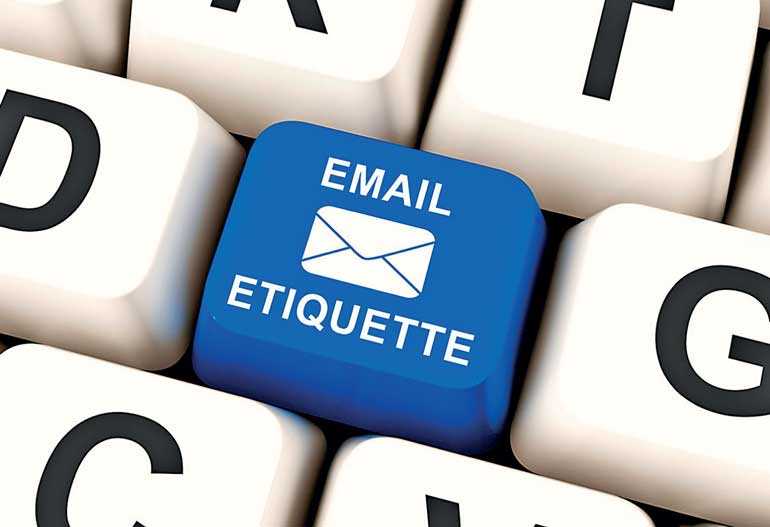Monday Apr 21, 2025
Monday Apr 21, 2025
Tuesday, 13 August 2019 00:00 - - {{hitsCtrl.values.hits}}

Your email is a reflection of you
Very often I am subjected to poorly composed, or ambiguous emails, with careless spelling and poor grammar. In the companies I worked, I always provided email guidelines to the staff and this made a significant difference and even enhanced the image of the companies. Therefore I felt I should disseminate this guide for the benefit of the country.
These are simple guidelines based on my practical experience, and also following the examples of the Japanese people I have worked with. These guidelines are intended to make email communication more efficient, more accurate, and more precise. Thisis by no means an exhaustive list but hopefully contains some useful suggestions.
1. Subject line
a. Sometimes you may click reply all when you need to send an email to the same recipients, but on a different subject. Never do this. Always change the subject as appropriate. This aids people to carry out searches of all emails on a particular subject and substantially reduce confusion.
b. Wherever appropriate the subject line must “say it all”, because busy people may have time only to see the subject line and will decide which email to open. For example if the XYZ meeting is postponed and this has to be communicated, do not simply say “XYZ meeting” in the subject line. It is better to say “Postponed – XYZ meeting”. The recipient will grasp the message immediately. If not the recipient may assume it is a reminder and may not even open it. So consider using “Reminder XYZ meeting”, “Today – XYZ meeting”,“Last day – ABC seminar registration”, “Closing today…” and so on.

2. Recipients
a. Be extremely careful when you select recipients from the pop-up list because you do not want the email to go to wrong people. After the names have been inserted please recheck. I have several times received emails intended for other Sunils.
b. Use group email, but make sure it is revised regularly. You would not want someone who is no longer in the loop to receive your email. In one organisation I kept on receiving emails even after I left the organisation because my email was not removed. HR should remind all staff that so and so has resigned and that the email address should be removed from the group.
3. Copies (CC)
Copy all relevant people. This will ensure that everyone is in the “loop”. This is very useful to avoid distortion with serial communication. However do not just copy, just because it is so easy to do so on email. This will only clutter other peoples’ inboxes. Often I receive replies to group emails which are totally irrelevant to me. Recently an organiser of a group visit sent an email to all participants asking for their food preferences. Some replied to “all” instead of only the organiser. I wonder why he thought all others should be interested in his food preference. This is how our inboxes get cluttered.
4. Blind copies (BCC)
Sending blind copies is not considered a very polite thing to do. But there may be situations where you may have to resort to it. However consider it carefully.
5. Forwarding emails
Forwarding others emails can be tricky and avoid it if you can.
The worst is when you forward an email you have received without deleting the sender details. Once an email internal memo I sent to my staff regarding the need for unity and containing some stories had been forwarded a multiple times and a friend of mine living overseas sends it back to me. My name and designation, etc. were still intact.
If you must forward someone’s email to others, it is best to obtain the consent of the original sender, and even then delete the sender details, unless keeping them intact is relevant.
6. Body of email
a. Remember that according to management guru Peter Drucker, the responsibility of communicating lies with the sender of the message, rather than the receiver. Therefore if the receiver has misunderstood the message, the fault is with the sender, not the recipient. Peter Drucker further says that if the recipient has not understood, then the sender has not communicated, but only “uttered”. Therefore make the message very clear and unambiguous. Read it again and make it clearer.
b. Compose the email in point form, keeping one issue or point in one bulleted paragraph. Be precise and concise. An example is as follows:
I know we were taught to write essays in school, but there is no doubt that crisp point form communication is far better in a business environment.
c. You may bold or highlight very important matters, dates and figures. Please do not overdo it because an email with a lot of bold, coloured and highlighted text can be very irritating.
d. If you are informing the details of a meeting the following format is recommended.
(Parking and dress code are not always necessary)
e. Many people have email on their smart phones and therefore these details will be available for reference at any time. Also for those using Google calendar the meeting reminder will pop up with the Google map and the location pointed out.
f. Consider introducing standards for dates, numbers, and unitsetc., to avoid ambiguity. You may consult the Sri Lanka Standards Institute (SLSI) for the standard formats. However in brief the standard formats are as follows:
g. If you are replying to an email sent to you, it is acceptable to say “please see below for my replies” and insert your reply in the original email. However please use a different colour to distinguish the reply from the original. This is more suitable if the request is in a list form. For example if the request list asks for your full name, address, mobile number, passport number, etc.
h. If you are communicating with your colleagues you may be informal and use abbreviations. But communicating with external recipients should be more formal.
i. In the case of emails to overseas recipients or to foreigners do not use commonly understood terms and abbreviations as they may not mean the same to non Sri Lankans.
j. Emails to external parties must portray your concern for quality and therefore be mindful of spelling, capitalisation, etc. Do not project yourself as a sloppy and tardy individual.
k. Always re-read your emails before clicking the “send” button. You may have inadvertently missed a word, not made the point unambiguous, or made a spelling mistake. Earn a reputation for accurate emails.
l. Emails are for very simple communications and should not be used for long texts and reports. If you really need to include a table or picture then think whether it should be in the body or as an attachment.
7. Attachments
a. Attachments must be attached as soon as you type that an attachment is being sent. For example as soon as you type “please see the attachment,” click “attach file” and insert the attachment. This must be made a habit. If not, you may forget to attach the attachment. Do not wait for the email text to be completed.
b. Just before sending the email click on the attachment and verify it is the correct one. Once you open it thus and you decide to make a change and type it in and close it will not work because it is the original that will be sent.
c. If you are sending large attachments with many pictures, or large power point presentations, you may need to warn the recipient. His computer may get stuck. Some servers reject large files.
d. Some may not like to spend time opening attachments. If the attachment needs immediate attention and is not too cumbersome consider inserting it in the body of the email itself. You may have noticed that some e-marketing emails were sent as attachments earlier, but after they discovered that many were unopened, now it is always in the body of the email.
8. Signature
a. Never sign off with your name only, and the worst is using your commonly used name. This is however permitted if you are on a first name relationship, and the other party knows your designation and contact details.
b. Always have a standard signature approved by the office and containing your designation, address, and contact details. This avoids the inconvenience of finding who you are and how to contact you. In some organisations this is a part of the branding system to prevent staff designing their own email signatures. If your branding manual does not contain specification for the signature line consider including it.
c. If your organisation has won some awards it could be included in the signature line.
d. If there is an approved message (e.g.:Be concerned about the environment) that could be included in the signature area.
9. Etiquette
a. Never use a lot of bold capital letters. It is akin to shouting at the recipient.
b. Always be polite and not demanding.
c. Do not forward unnecessary emails and jokes.
d. Do not send or forward emails containing libellous, defamatory, offensive, racist or obscene remarks
e. Acknowledge when you receive an email. If you are unable to respond to the request made or information sought immediately, still send an interim reply and convey that you are in receipt of the email and that you will respond soon. If you can indicate a time or date when you can finally respond it will be better. If you do so you must honour your promise.
10. Email is not private
Please remember that emails sent from your office email server are not private, and your office has the right to access it.
11. Disclaimer
Many organisations use a standard disclaimer. You may consider inserting one as appropriate
Remember your email is a reflection of you. If you ask your secretary to send emails through your email address you are still responsible for the content, language and format
(The writer is an awardee of the APO Regional Award for promoting productivity in the Asia Pacific Region; Consultant on Productivity, Quality Management, and Japanese Management Techniques.)
Discover Kapruka, the leading online shopping platform in Sri Lanka, where you can conveniently send Gifts and Flowers to your loved ones for any event including Valentine ’s Day. Explore a wide range of popular Shopping Categories on Kapruka, including Toys, Groceries, Electronics, Birthday Cakes, Fruits, Chocolates, Flower Bouquets, Clothing, Watches, Lingerie, Gift Sets and Jewellery. Also if you’re interested in selling with Kapruka, Partner Central by Kapruka is the best solution to start with. Moreover, through Kapruka Global Shop, you can also enjoy the convenience of purchasing products from renowned platforms like Amazon and eBay and have them delivered to Sri Lanka.
Discover Kapruka, the leading online shopping platform in Sri Lanka, where you can conveniently send Gifts and Flowers to your loved ones for any event including Valentine ’s Day. Explore a wide range of popular Shopping Categories on Kapruka, including Toys, Groceries, Electronics, Birthday Cakes, Fruits, Chocolates, Flower Bouquets, Clothing, Watches, Lingerie, Gift Sets and Jewellery. Also if you’re interested in selling with Kapruka, Partner Central by Kapruka is the best solution to start with. Moreover, through Kapruka Global Shop, you can also enjoy the convenience of purchasing products from renowned platforms like Amazon and eBay and have them delivered to Sri Lanka.